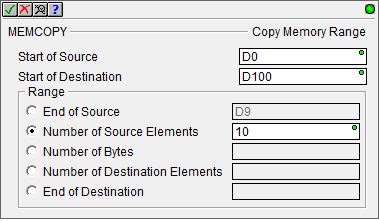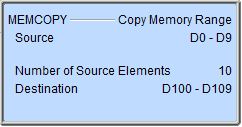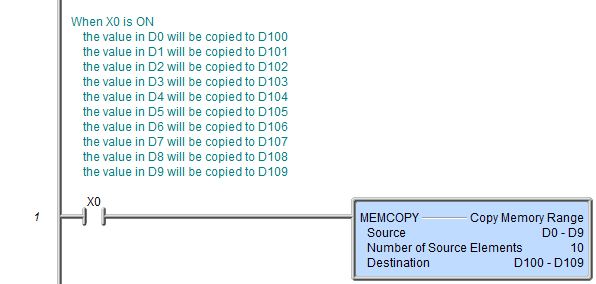Topic: DMD0007
MEMCOPY - Copy Memory Range
The Copy Memory Range (MEMCOPY) instruction is used to copy bytes of
data from one range of memory locations to another range of memory locations
without regard to the format of the data in the memory locations. No data
conversion will be applied during the copy operation. The source and destination ranges can overlap which allows implementation
of things like value shifting and LIFO / FIFO queues or stacks. The Copy Memory Range instruction is the proper instruction to copy
structures - for example Date / Time structures - making it especially useful
in moving structures into and out of Guest Protocol Memory![]() These are blocks of memory specically created for the use by the Do-more controller to handle external communication devices. For example the MI, MC, MIR and MHR memory blocks for communicating with Modbus clients, and DLX, DLY, DLC and DLV memory blocks for communicating with DirectLOGIC clients..
These are blocks of memory specically created for the use by the Do-more controller to handle external communication devices. For example the MI, MC, MIR and MHR memory blocks for communicating with Modbus clients, and DLX, DLY, DLC and DLV memory blocks for communicating with DirectLOGIC clients..

To move one or more memory locations with regard to the data format,
consider using the MOVE - Move Value
or MOVER - Move Range of Values
instruction.
Parameters:
Note: Use the F9 key or click the 'three dot box' at the right edge of the parameter field to open the Default Element Selection Tool (the Element Picker or the Element Browser) or use the Down-Arrow key (Auto-Complete) on any parameter field to see a complete list of the memory locations that are valid for that parameter of the instruction.
Start of Source - specifies the first memory location of the data to copy. This can be any readable location (including structures).
Start of Destination - specifies the first memory location of the where the data is to be copied. This can be any writable location (including structures).
Range - specifies the number of bytes of data to copy by selecting one of the following five options:
-
End of Source - calculates the number of bytes by specifying the last memory location in the range of values to copy. This memory location must be in the same block as the Start of Source, and the ID of the end memory location must be greater than the ID of the source memory location.
-
Number of Source Elements - calculates the number of bytes by specifying the number of source elements in the range. This can be any constant value up to the number of memory locations in the block, or any readable numeric location.
-
Number of Bytes - specifies the number of bytes of data to copy. This can be any constant value up to the number of bytes of memory in the block, or any readable numeric location.
-
Number of Destination Elements - calculates the number of bytes by specifying the number of destination elements in the range. This can be any constant value up to the number of memory locations in the destination data block, or any readable numeric location.
-
End of Destination - calculates the number of bytes by specifying the last memory location in the destination range. This memory location must be in the same block as the Start of Destination, and the ID of the end memory location must be greater than the ID of the source memory location.
Status Display:

The status display for the Copy Memory Range instruction will show the beginning and ending elements of the source and destinations ranges.
See Also:
MEMCOPY - Copy Memory Range
REFWRITE - Write Value Indirectly
STRCOPYR - Copy a Range of Strings
Rung Example:

